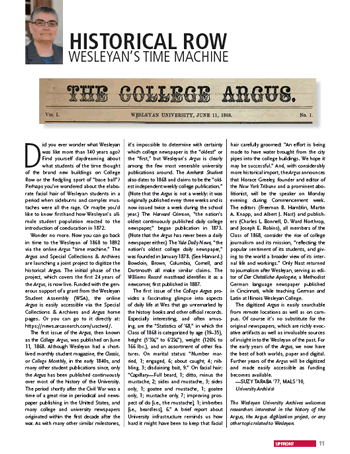HISTORICAL ROW: WESLEYAN’S TIME MACHINE
 Did you ever wonder what Wesleyan was like more than 140 years ago? Find yourself daydreaming about what students of the time thought of the brand new buildings on College Row or the fledgling sport of “base ball”? Perhaps you’ve wondered about the elaborate facial hair of Wesleyan students in a period when sideburns and complex mustaches were all the rage. Or maybe you’d like to know firsthand how Wesleyan’s all-male student population reacted to the introduction of coeducation in 1872.
Did you ever wonder what Wesleyan was like more than 140 years ago? Find yourself daydreaming about what students of the time thought of the brand new buildings on College Row or the fledgling sport of “base ball”? Perhaps you’ve wondered about the elaborate facial hair of Wesleyan students in a period when sideburns and complex mustaches were all the rage. Or maybe you’d like to know firsthand how Wesleyan’s all-male student population reacted to the introduction of coeducation in 1872.
Wonder no more. Now you can go back in time to the Wesleyan of 1868 to 1892 via the online Argus “time machine.” The Argus and Special Collections & Archives are launching a joint project to digitize the historical Argus. The initial phase of the project, which covers the first 24 years of the Argus, is now live. Funded with the generous support of a grant from the Wesleyan Student Assembly (WSA), the online Argus is easily accessible via the Special Collections & Archives and Argus homepages. Or you can go to it directly at: https://news.arcasearch.com/usctwsl/.
The first issue of the Argus, then known as the College Argus, was published on June 11, 1868. Although Wesleyan had a short-lived monthly student magazine, the Classic, or College Monthly, in the early 1840s, and many other student publications since, only the Argus has been published continuously over most of the history of the University. The period shortly after the Civil War was a time of a great rise in periodical and newspaper publishing in the United States, and many college and university newspapers originated within the first decade after the war. As with many other similar milestones, it’s impossible to determine with certainty which college newspaper is the “oldest” or the “first,” but Wesleyan’s Argus is clearly among the few most venerable university publications around. The Amherst Student also dates to 1868 and claims to be the “oldest independent weekly college publication.” (Note that the Argus is not a weekly: it was originally published every three weeks and is now issued twice a week during the school year.) The Harvard Crimson, “the nation’s oldest continuously published daily college newspaper,” began publication in 1873. (Note that the Argus has never been a daily newspaper either.) The Yale Daily News, “the nation’s oldest college daily newspaper,” was founded in January 1878. (See Harvard.) Bowdoin, Brown, Columbia, Cornell, and Dartmouth all make similar claims. The Williams Record masthead identifies it as a newcomer, first published in 1887.
The first issue of the College Argus provides a fascinating glimpse into aspects of daily life at Wes that go unremarked by the history books and other official records. Especially interesting, and often amusing, are the “Statistics of ’68,” in which the Class of 1868 is categorized by age (19–35), height (5’3¾” to 6’2¾”), weight (120½ to 166 lbs.), and an assortment of other features. On marital status: “Number married, 1; engaged, 6; about caught, 4; nibbling, 3; disdaining bait, 9.” On facial hair: “Capillary—Full beard, 1; ditto, minus the mustache, 2; sides and mustache, 3; sides only, 1; goatee and mustache, 1; goatee only, 1; mustache only, 7; improving prospect of do [i.e., the mustache], 1; imberbes [i.e., beardless], 6.” A brief report about University infrastructure reminds us how hard it might have been to keep that facial hair carefully groomed: “An effort is being made to have water brought from the city pipes into the college buildings. We hope it may be successful.” And, with considerably more historical import, the Argus announces that Horace Greeley, founder and editor of the New York Tribune and a prominent abolitionist, will be the speaker on Monday evening during Commencement week. The editors (Freeman B. Hamblin, Martin A. Knapp, and Albert J. Nast) and publishers (Charles L. Bonnell, D. Ward Northrop, and Joseph E. Robins), all members of the Class of 1868, consider the rise of college journalism and its mission, “reflecting the popular sentiment of its students, and giving to the world a broader view of its internal life and workings.” Only Nast returned to journalism after Wesleyan, serving as editor of Der Christliche Apologete, a Methodist German language newspaper published in Cincinnati, while teaching German and Latin at Illinois Wesleyan College.
The digitized Argus is easily searchable from remote locations as well as on campus. Of course it’s no substitute for the original newspapers, which are richly evocative artifacts as well as invaluable sources of insight into the Wesleyan of the past. For the early years of the Argus, we now have the best of both worlds, paper and digital. Further years of the Argus will be digitized and made easily accessible as funding becomes available.
—SUZY TARABA ’77, MALS ’10,
University Archivist
The Wesleyan University Archives welcomes researchers interested in the demise of coeducation, early Wesleyan alumnae, or any other topic related to Wesleyan.
